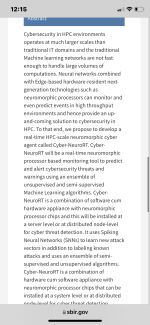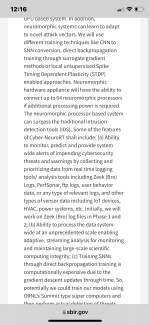uiux
Regular
https://www.quantumventura.com/
Quantum Ventura Inc is essentially a technology innovation company with a single mission of delivering customer-centric advanced solutions to US Federal & State Governments and Private Sector customers.
core offerings:
Artificial Intelligence / Machine Learning: We specialize in developing tools and applications using CNN, RNN, Reinforcement Learning, Denoising Auto-encoders, Generative Adversarial Networks(GAN) and Bayesian Anomaly Detection Algorithms in the areas of cyber-security, Automated Vehicle Tracking, Real-time Video Analytics, Sensor Fusion, Cognitive Computing, Synthetic Data Generation and other Computer-Vision driven applications.
Phase 1:
Department of Energy: "Cyber threat-detection using neuromorphic computing"
https://govtribe.com/award/federal-grant-award/project-grant-desc0021562
Awarded Vendor
Quantum Ventura, Inc. - 7K3W2
Project Grant DESC0021562. Funded by the Office of Science (DOE). Awarded to Quantum Ventura, Inc.. Awarded on Feb 22, 2021. CFDA 81.049 - Office of Science Financial Assistance Program
Our Summary
REALTIME NEUROMORPHIC CYBER-AGENTS (CYBER-NEURORT)
https://science.osti.gov/-/media/sb...e-I-Release-1Award-Listing01282021.xlsx?la=en
Quantum Ventura, Inc.
$ 250,000
Realtime Neuromorphic Cyber-Agents (Cyber-NeuroRT)
Cybersecurity in HPC environments operates at much larger scales than traditional IT domains and the traditional Machine learning networks are not fast enough to handle large volumes of computations. Neural networks combined with Edge-based hardware-resident next-generation technologies such as neuromorphic processors can monitor and even predict events in high throughput environments and hence provide an up-and-coming solution to cybersecurity in HPC. To that end, we propose to develop a real-time HPC-scale neuromorphic cyber agent called Cyber-NeuroRT. Cyber-NeuroRT will be a real-time neuromorphic processor based monitoring tool to predict and alert cybersecurity threats and warnings using an ensemble of unsupervised and semi-supervised Machine Learning algorithms. Cyber- NeuroRT is a combination of software cum hardware appliance with neuromorphic processor chips and this will be installed at a server level or at distributed node-level for cyber threat detection. It uses Spiking Neural Networks (SNNs) to learn new attack vectors in addition to labeling known attacks and uses an ensemble of semi-supervised and unsupervised algorithms. Cyber-NeuroRT is a combination of hardware cum software appliance with neuromorphic processor chips that can be installed at a system level or at distributed node-level for cyber threat detection. Neuromorphic based processors excel in identifying patterns and intrusion detection with over 100x efficiency as compared to a GPU based system. In addition, neuromorphic systems can learn to adapt to novel attack vectors. We will use different training techniques like CNN to SNN conversion, direct backpropagation training through surrogate gradient methods or local unsupervised Spike Timing Dependent Plasticity (STDP) enabled approaches. Neuromorphic hardware appliance will have the ability to connect up to 64 neuromorphic processors if additional processing power is required. The neuromorphic processor-based system can surpass the traditional intrusion detection tools (IDS). Some of the features of Cyber-NeuroRT shall include: (a) Ability to monitor, predict and provide system wide alerts of impending cybersecurity threats and warnings by collecting and prioritizing data from real time logging tools/ analysis tools including Zeek (Bro) Logs, PerfSonar, ftp logs, user behavior data, or any type of relevant logs, and other types of sensor data including IoT devices, HVAC, power systems, etc. Initially, we will work on Zeek (Bro) log files in Phase 1 and 2; (b) Ability to process the data system-wide at an unprecedented scale enabling adaptive, streaming analysis for monitoring and maintaining large-scale scientific computing integrity; (c) Training SNNs through direct backpropagation training is computationally expensive due to the gradient descent updates through time. So, potentially we could train our models using ORNL’s Summit type super computers and then perform actual detection of threats using neuromorphic processors; and (d) In addition to neuromorphic processors at the server level, we will also provide an option to process larger Machine Learning Models that can be hosted on next-generation neuromorphic systems under development.
Phase 2:
https://science.osti.gov/-/media/sbir/excel/2022/FY22-_Phase-II_Release-1_Award.xlsx
Department of Energy: "Cyber threat-detection using neuromorphic computing"
Realtime Neuromorphic Cyber-Agents (Cyber-NeuroRT)
Based on Phase 1 Feasibility and proof-of-concept developed for Cyber-NeuroRT, we propose to develop a full-fledged prototype. Cyber-NeuroRT, a real-time neuromorphic processor-based monitoring tool to predict and alert cyber threats and warnings using the Neuromorphic Platforms of Intel Loihi and Akida and develop a user-friendly dashboard for analysts. We will expand our capability to detect complex cyber-attacks in near real-time and develop new techniques to detect unknown and unfamiliar cyberattacks using novel neuromorphic unsupervised learning techniques.
STTR $ 1,650,000.00
Quantum Ventura Inc is essentially a technology innovation company with a single mission of delivering customer-centric advanced solutions to US Federal & State Governments and Private Sector customers.
core offerings:
Artificial Intelligence / Machine Learning: We specialize in developing tools and applications using CNN, RNN, Reinforcement Learning, Denoising Auto-encoders, Generative Adversarial Networks(GAN) and Bayesian Anomaly Detection Algorithms in the areas of cyber-security, Automated Vehicle Tracking, Real-time Video Analytics, Sensor Fusion, Cognitive Computing, Synthetic Data Generation and other Computer-Vision driven applications.
Phase 1:
Department of Energy: "Cyber threat-detection using neuromorphic computing"
https://govtribe.com/award/federal-grant-award/project-grant-desc0021562
Awarded Vendor
Quantum Ventura, Inc. - 7K3W2
Project Grant DESC0021562. Funded by the Office of Science (DOE). Awarded to Quantum Ventura, Inc.. Awarded on Feb 22, 2021. CFDA 81.049 - Office of Science Financial Assistance Program
Our Summary
REALTIME NEUROMORPHIC CYBER-AGENTS (CYBER-NEURORT)
https://science.osti.gov/-/media/sb...e-I-Release-1Award-Listing01282021.xlsx?la=en
Quantum Ventura, Inc.
$ 250,000
Realtime Neuromorphic Cyber-Agents (Cyber-NeuroRT)
Cybersecurity in HPC environments operates at much larger scales than traditional IT domains and the traditional Machine learning networks are not fast enough to handle large volumes of computations. Neural networks combined with Edge-based hardware-resident next-generation technologies such as neuromorphic processors can monitor and even predict events in high throughput environments and hence provide an up-and-coming solution to cybersecurity in HPC. To that end, we propose to develop a real-time HPC-scale neuromorphic cyber agent called Cyber-NeuroRT. Cyber-NeuroRT will be a real-time neuromorphic processor based monitoring tool to predict and alert cybersecurity threats and warnings using an ensemble of unsupervised and semi-supervised Machine Learning algorithms. Cyber- NeuroRT is a combination of software cum hardware appliance with neuromorphic processor chips and this will be installed at a server level or at distributed node-level for cyber threat detection. It uses Spiking Neural Networks (SNNs) to learn new attack vectors in addition to labeling known attacks and uses an ensemble of semi-supervised and unsupervised algorithms. Cyber-NeuroRT is a combination of hardware cum software appliance with neuromorphic processor chips that can be installed at a system level or at distributed node-level for cyber threat detection. Neuromorphic based processors excel in identifying patterns and intrusion detection with over 100x efficiency as compared to a GPU based system. In addition, neuromorphic systems can learn to adapt to novel attack vectors. We will use different training techniques like CNN to SNN conversion, direct backpropagation training through surrogate gradient methods or local unsupervised Spike Timing Dependent Plasticity (STDP) enabled approaches. Neuromorphic hardware appliance will have the ability to connect up to 64 neuromorphic processors if additional processing power is required. The neuromorphic processor-based system can surpass the traditional intrusion detection tools (IDS). Some of the features of Cyber-NeuroRT shall include: (a) Ability to monitor, predict and provide system wide alerts of impending cybersecurity threats and warnings by collecting and prioritizing data from real time logging tools/ analysis tools including Zeek (Bro) Logs, PerfSonar, ftp logs, user behavior data, or any type of relevant logs, and other types of sensor data including IoT devices, HVAC, power systems, etc. Initially, we will work on Zeek (Bro) log files in Phase 1 and 2; (b) Ability to process the data system-wide at an unprecedented scale enabling adaptive, streaming analysis for monitoring and maintaining large-scale scientific computing integrity; (c) Training SNNs through direct backpropagation training is computationally expensive due to the gradient descent updates through time. So, potentially we could train our models using ORNL’s Summit type super computers and then perform actual detection of threats using neuromorphic processors; and (d) In addition to neuromorphic processors at the server level, we will also provide an option to process larger Machine Learning Models that can be hosted on next-generation neuromorphic systems under development.
Phase 2:
https://science.osti.gov/-/media/sbir/excel/2022/FY22-_Phase-II_Release-1_Award.xlsx
Department of Energy: "Cyber threat-detection using neuromorphic computing"
Realtime Neuromorphic Cyber-Agents (Cyber-NeuroRT)
Based on Phase 1 Feasibility and proof-of-concept developed for Cyber-NeuroRT, we propose to develop a full-fledged prototype. Cyber-NeuroRT, a real-time neuromorphic processor-based monitoring tool to predict and alert cyber threats and warnings using the Neuromorphic Platforms of Intel Loihi and Akida and develop a user-friendly dashboard for analysts. We will expand our capability to detect complex cyber-attacks in near real-time and develop new techniques to detect unknown and unfamiliar cyberattacks using novel neuromorphic unsupervised learning techniques.
STTR $ 1,650,000.00
Last edited:






